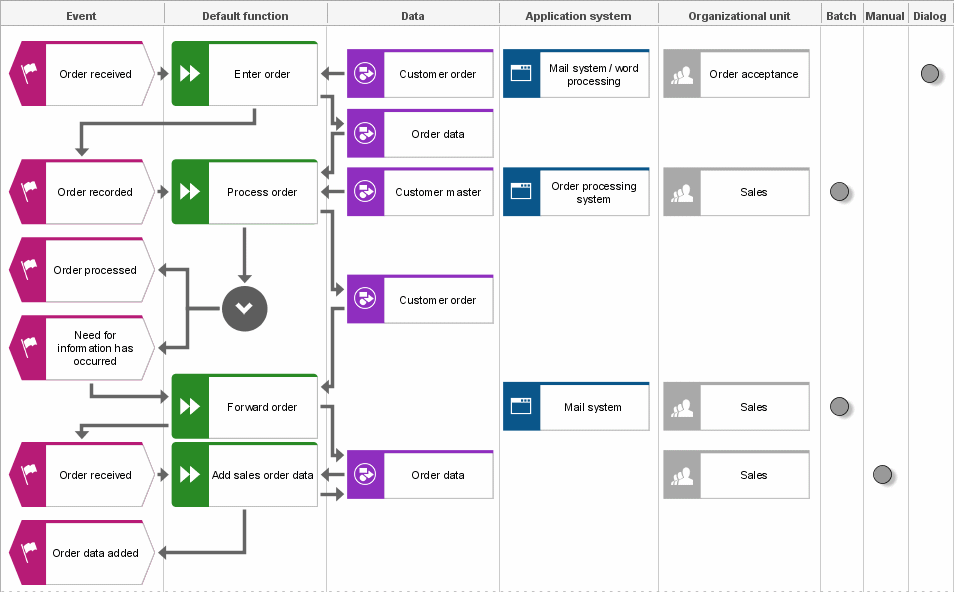Process chain diagram (PCD)
A process chain diagram represents a closed process chain. All views of a business process (organization view, data view, function view, resource view) are expressed with their relationships in a coherent form.
The following figure shows an example of the process chain for Order processing.
The two columns on the left represent the chronological-logical operational sequence of the business process under consideration. Individual functions of the procedure are listed in the second column and linked to the events by which they are triggered and which they generate. The connections between functions and events define exactly which events trigger functions and which events are generated by functions and thus regulate the control flow between functions. In the example given, the Order received event triggers the Enter order function. The result of this function is defined by the Order entered end event. This event triggers the next function, called Process order. This way of connecting events and functions produces a chronological-logical operational sequence of functions, a so-called process chain. Logical dependencies of possible branches and loops in the control flow can be expressed by means of rules.
Input and output data required by the functions are represented in the form of Cluster/Data models in the next column. The Process order function requires Order data and Customer master data as the input data and creates the customer order as the output data. The representation can be restricted to information objects, or may also include the information carriers (media) containing the information. An information carrier can be a document, list, handwritten receipt, or storage medium, such as a hard disk.
In the column on the right, the organizational units (departments) responsible for carrying out the relevant function are specified.
The Type of processing (Dialog, Batch, Manually) and Application system columns provide additional information about the degree to which IT support is available for a function. The application system or application system components that are used are entered in the Application system column. The Type of processing column specifies in more detail how a function is to be carried out, the options being dialog, batch, or manual processing.
When using a process chain diagram to analyze business processes that describe an actual situation, weak points in the current problem resolution method can be shown. These weak points can be either media breaks between IT-based and manual processing steps, or organizational breaks (e.g., frequent replacement of the department/organizational unit in charge). In particular, the analysis reveals data redundancies, duplicates, and time delays within a procedure, thus enabling the user to derive various ideas for improving the target procedure to be defined.
Process chain diagrams describing the initial situation are created at a relatively high level of aggregation. Since they are primarily used for displaying the interaction of all ARIS components, they also serve as a means of representation within the ARIS control view (see chapter
Process view/Control view). The control view provides not only process chain diagrams, but also event-driven process chains (EPCs) (see chapter
Event control - Event-driven process chain (EPC)). Event-driven process chains offer the same modeling capabilities as PCDs, with the difference that objects are not placed in predefined columns due to the free-form representation. If the procedure model is to be consistently supported by only one model type (PCD or EPC), the target procedure can also be displayed as an EPC.
The description of other modeling methods follows the ARIS concept. First, the views (function view, data view, organization view, control view) are described, followed by the descriptive levels (requirements definition, design specification, implementation) within these views.

